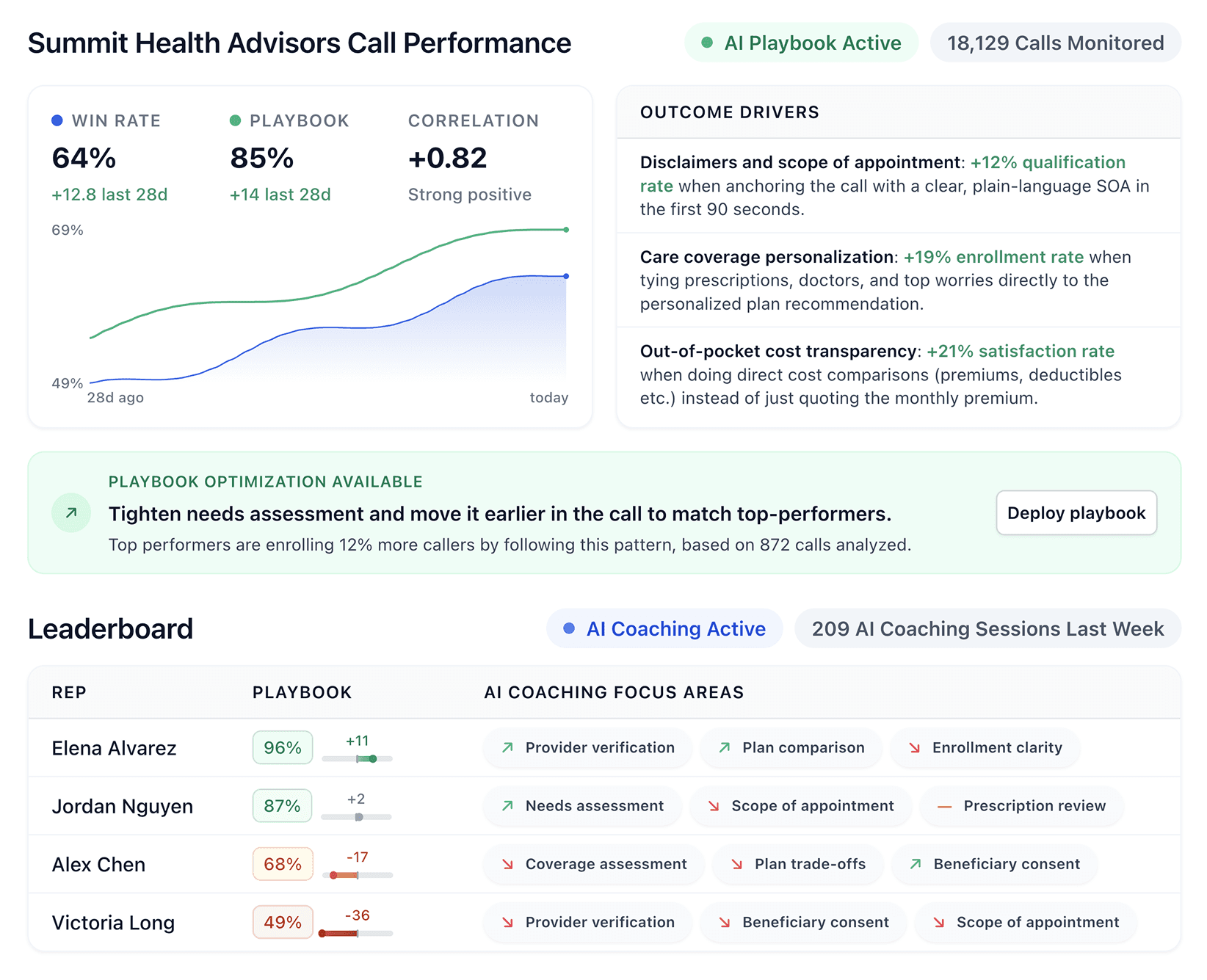Written by
Alpharun Team
Reviewed by
Alpharun Team
Published on
Oct 27, 2025
Your brand lives in every customer conversation, but manual quality assurance (QA) misses most of them and catches issues after it’s too late.
That’s why more teams use quality monitoring software. It reviews every call in real time, spots coaching opportunities, and gives leaders a clear view of where service excels and where it slips.
In this guide, we’ll compare the top platforms, break down how call-center quality monitoring software works, and walk through how to choose the right fit for your contact center.
The 6 best call-center quality monitoring software
The right QA software depends on your team's goals. QA call-center tools and platforms vary widely in features and focus.
This table helps you compare top options, their best use cases, starting prices, and integrations:
Tool | Best For | Starting Price | Integrations |
|---|---|---|---|
Alpharun | Large sales teams in insurance, mortgages, and healthcare that need custom-trained AI for deep, compliant coaching | Enterprise pricing | Five9, Genesys, and all major call center platforms (fast integration capability) |
Observe.AI | Enterprises with contact centers in finance, insurance, travel, retail, and healthcare | Custom pricing | Salesforce, HubSpot, Zendesk, and many more |
Balto | Best for B2C contact centers needing real-time guidance, coaching, and QA. | Custom pricing | Five9, Genesys, Salesforce, NICE inContact, and many more |
Cresta | Large enterprises in finance, telecom, and healthcare that need real-time agent assist and insights. | Custom pricing | Five9, Genesys, Salesforce, Cisco, and many more |
Gong | Mid-to-large B2B sales teams, RevOps, and sales leaders. | Custom pricing | Salesforce, HubSpot, Dynamics 365 |
CallMiner | Large contact centers with analyst teams focused on customer experience insights and compliance visibility. | Custom pricing | Five9, Genesys, CISCO, and many more |
1. Alpharun
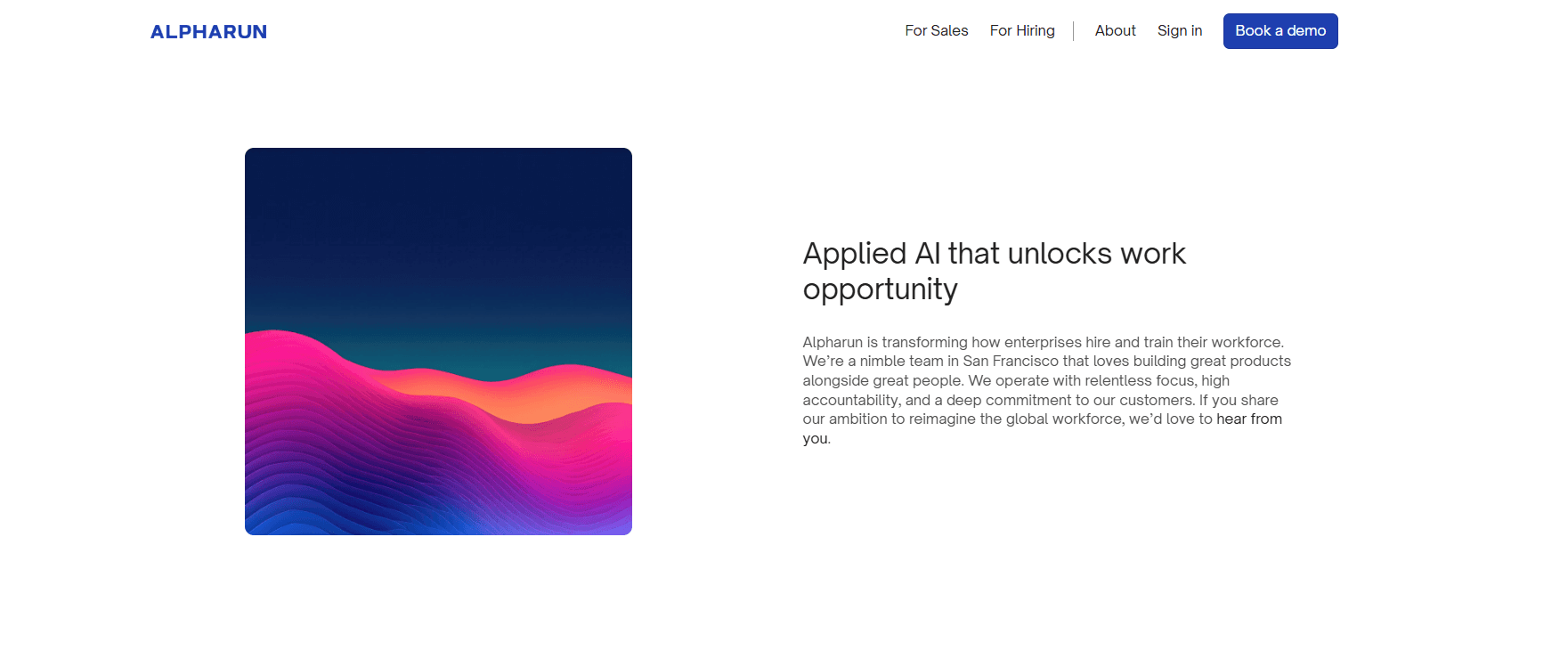
Alpharun analyzes your actual calls to identify what drives results, then trains custom AI models on your specific sales process and compliance requirements. The platform doesn't rely on generic coaching about talk ratios or objection handling.
It learns your business's unique best practices and coaches reps at the sentence level based on exactly what works in your industry.
This approach gives leaders visibility into performance patterns across hundreds of calls and helps teams close gaps faster than manual coaching allows.
Key features of Alpharun
Custom playbooks trained on your top calls analyzing best performers' conversations and compliance documentation to build AI models specific to your business
100% QA coverage with every call reviewed and scored, eliminating blind spots from sample-based monitoring
Sentence-level coaching with feedback tied directly to exact call moments, showing reps precisely what to say and when
AI voice agents for routine calls handling after-hours lead qualification, scheduling, and information gathering so human agents focus on complex conversations
Enterprise security and compliance with SOC 2 Type 2, HIPAA, and GDPR compliance plus end-to-end encryption
Performance dashboards tracking results by rep and team with comparisons against benchmarks
Automatic playbook updates that adapt as products, regulations, or customer behavior change
Pros and cons of Alpharun
Alpharun combines full QA coverage with targeted coaching to close performance gaps across teams. Smaller centers may find their enterprise focus more than they need.
Here’s a look at the key advantages and limitations:
Pros | Cons |
|---|---|
Custom-trained AI provides business-specific insights far beyond generic metrics like "talk-to-listen ratio". | Designed mainly for large-scale teams; smaller centers may find it more than they need. |
Feedback connects to exact conversation timestamps for clear, actionable coaching. | Custom pricing often exceeds mid-sized budgets. |
Designed for compliance-sensitive industries with built-in security standards. | Has less history and market recognition compared to long-standing QA providers. |
AI voice agents automate repetitive tasks while human agents handle high-value work. |
Pricing for Alpharun
Alpharun offers enterprise contracts through custom quotes. Pricing depends on team size, feature needs, and overall complexity.
Why Alpharun stands out
Alpharun works for teams that need AI models trained on their actual sales process, not generic industry templates. Teams in heavily regulated sectors like healthcare, financial services, and insurance use it to maintain compliance while closing performance gaps across hundreds of reps.
The platform analyzes every call, identifies patterns only visible at scale, and coaches agents with examples from real conversations.
Smaller teams or those wanting basic call recording may prefer lighter tools, but organizations handling complex, regulated sales benefit from coaching that understands their specific business.
2. Observe.AI
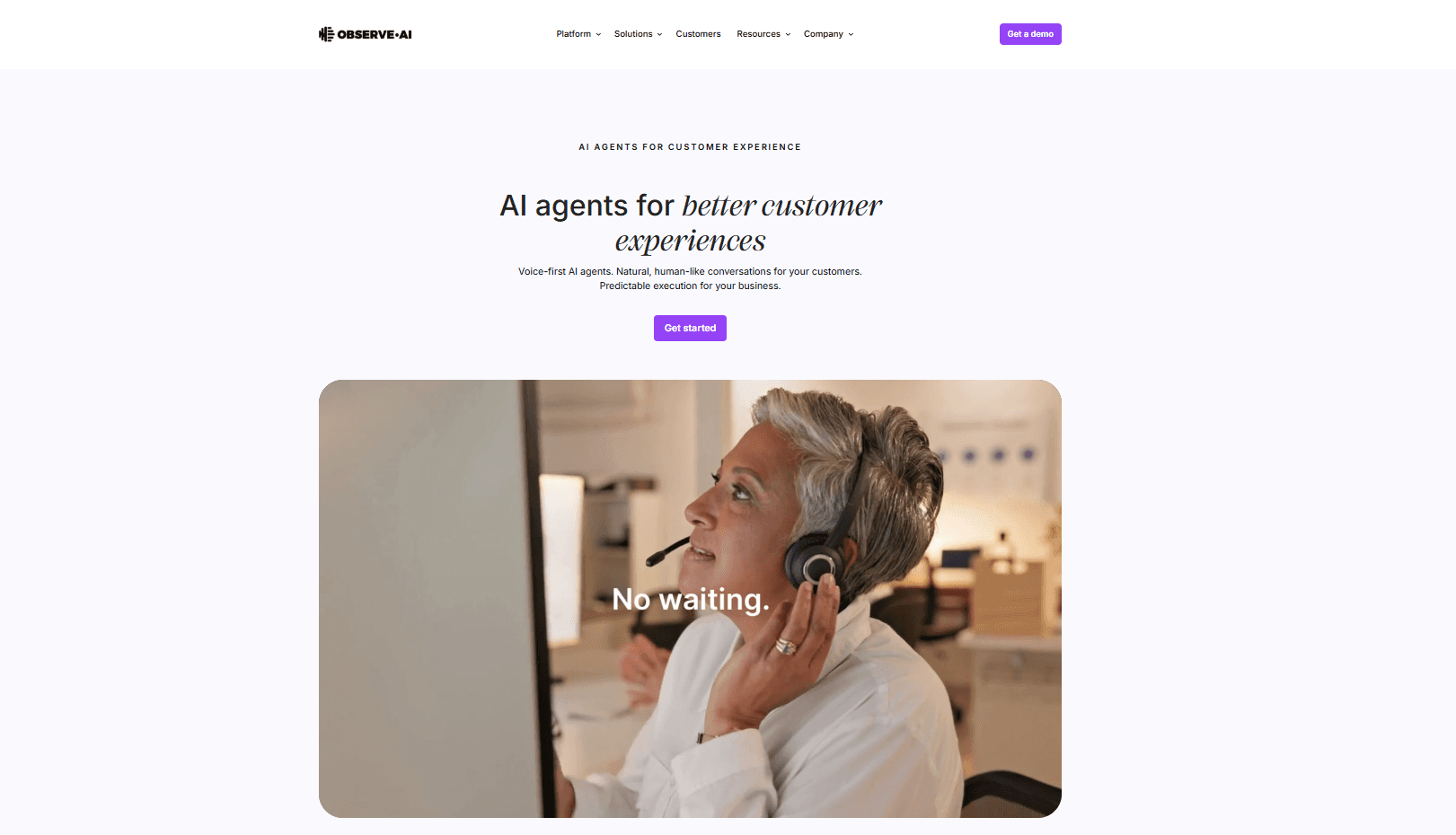
Observe.AI automates routine calls and monitors compliance. Healthcare and finance teams get the most value here.
The platform frees agents to tackle complex problems instead of repetitive work. However, the pricing structure is murky, and the best features live in premium tiers. Check what integrations you need and what they'll actually cost before you commit.
Key feature of Observe.AI
Voice-first AI agents that handle routine calls and free humans for complex conversations
ChatAI agents for lead generation, customer support, and quick handoff
AI Copilots that provide real-time guidance and automated workflows for human agents
Conversation Intelligence with Auto Quality Assurance (QA) and monitoring of 100% of calls
Pros and cons for Observe.AI
Observe.AI helps teams scale support and stay compliant. But it also comes with trade-offs that leaders need to weigh carefully.
Pros | Cons |
|---|---|
Automates large volumes of calls and chats through natural, human-like AI agents. | Some users report that transcription and comprehension accuracy drop in noisy or complex environments. |
Observe.AI enables fast insights, coaching, and VoiceAI agent creation. | Reviews note that it identifies QA themes but offers limited coaching recommendations. |
Integrates with Contact Center as a Service (CCaaS) and Customer Relationship Management (CRM) platforms through modular products. | Some users mention that detection accuracy issues and manual coaching make QA time-consuming. |
Pricing for Observe.AI
Observe.AI provides custom quotes based on team size.
When to choose Observe.AI
Observe.AI reduces call volume and supports agents in handling complex work, but pricing is unclear, and better features sit in higher tiers. Check integration needs and costs before signing.
3. Balto
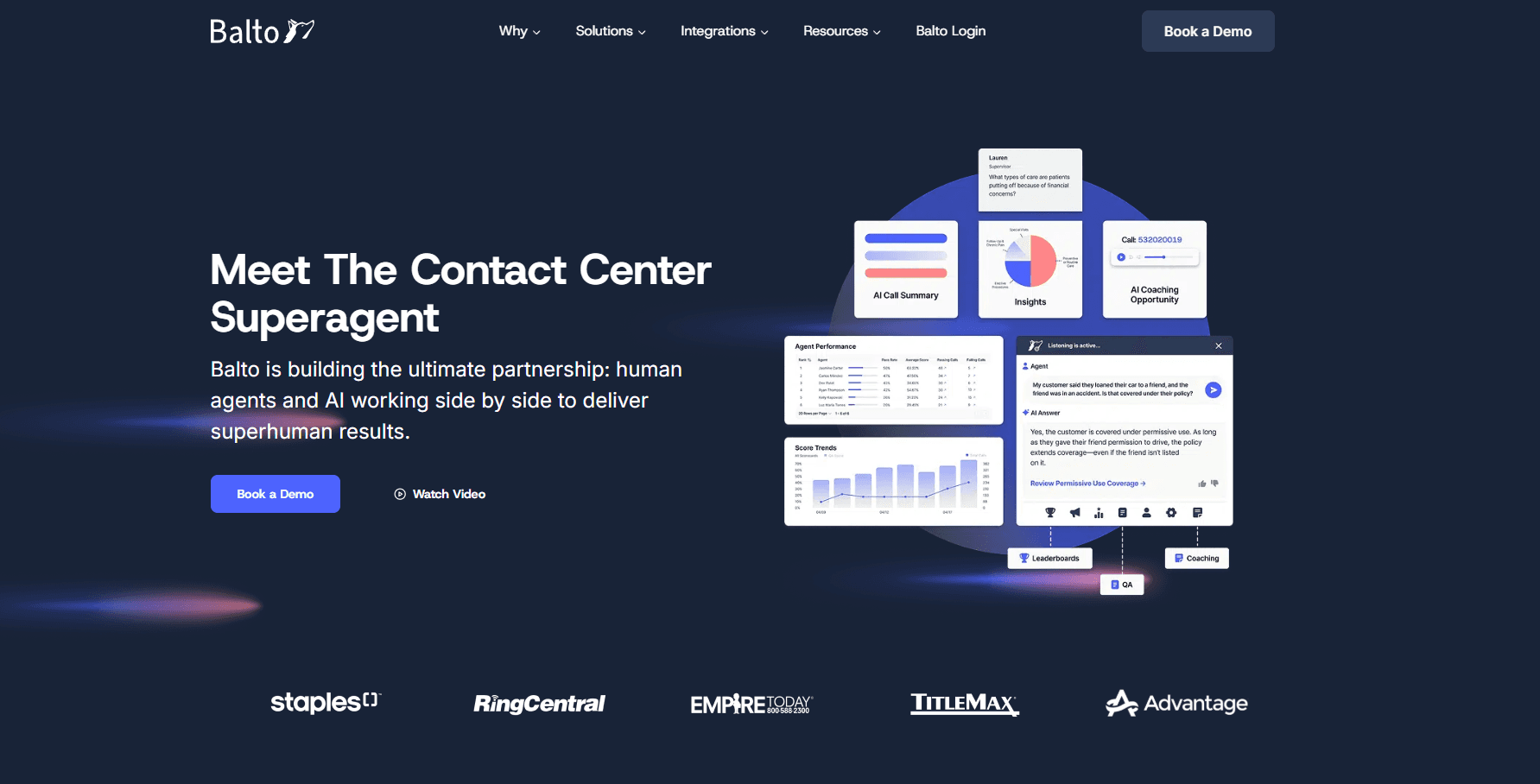
Balto is a real-time contact center guidance platform that listens to calls as they happen. It gives agents on-screen prompts, reminders, and tips to handle objections.
The platform keeps agents on script and compliant during calls. Leaders monitor performance live and step in when important conversations need help.
Key features of Balto
Objection-handling tips tailored to customer responses
Coaching dashboards that track adherence and performance
Smart checklist of talking points and dynamic prompts
Notifications that discourage bad habits in real time
Live manager alerts for critical calls
Pros and cons of Balto
Balto delivers strong real-time support but is less detailed when it comes to post-call analysis.
Pros | Cons |
|---|---|
Real-time coaching during calls | Reviews mention that overlapping alerts interrupt calls and affect agent concentration. |
Works across different CCaaS and CRM platforms for stack flexibility. | Integrations take 45 to 60 days to complete, which adds lead time before teams see value. |
Smart Checklists, prompts, and alerts help agents follow best practices. | Some users report challenges with certain edge cases in call summarization. |
Pricing for Balto
Balto uses custom pricing based on the number of agent seats and the length of your contract. Before signing, the team reviews the expected return on investment (ROI) with you.
Where Balto delivers value
Balto is a good fit for contact centers that need real-time nudges to keep agents on track and compliant. It saves calls before losing them and supports agents in the moment.
Balto offers minimal post-call development tools. It excels at real-time guidance for centers where call volume matters.
4. Cresta
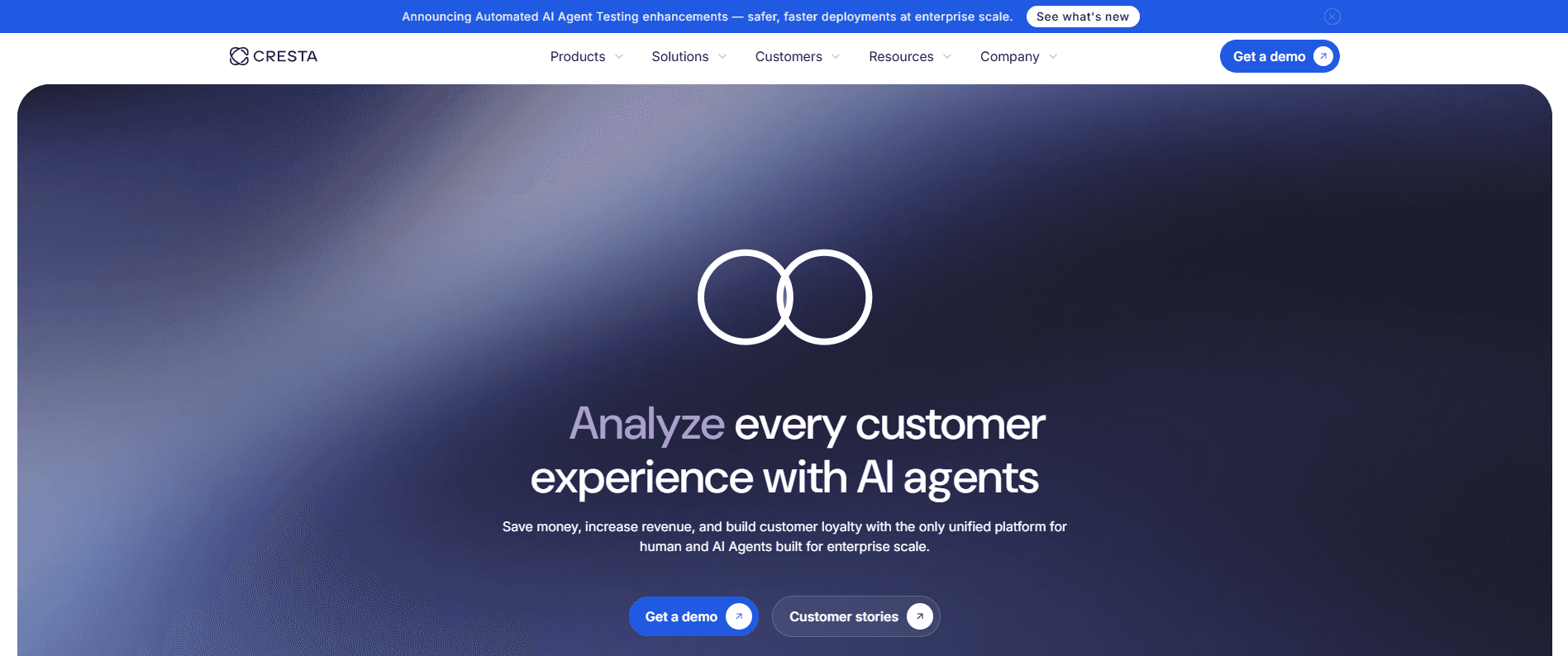
Cresta calls itself "human-centric AI." It automates routine tasks, guides agents during live calls, and extracts insights from every conversation.
Large enterprises in travel, retail, and financial services use the platform. Analysts rank it as a leader in conversation intelligence.
Key features of Cresta
AI Agent for voice and chat that automates common customer requests across channels
Agent Assist for real-time prompts, behavioral guidance, and AI-generated summaries
Knowledge Assist that connects agents to content and improves typing efficiency
Conversation Intelligence to surface insights, manage quality, and coach teams at scale
Broad integrations with Salesforce, Genesys, NICE, Twilio, Amazon Connect, and more
Pros and cons of Cresta
Cresta focuses on real-time support and omnichannel automation. However, adoption comes with trade-offs that teams must consider.
Pros | Cons |
|---|---|
Real-time Agent Assist improves accuracy and speeds up agent response. | User feedback notes that it lacks flexibility for unique processes. |
Conversation Intelligence gives leaders deep visibility into performance drivers. | Reviews mention a learning curve before Cresta delivers strong results. |
Omnichannel AI Agents and wide integrations make it flexible across platforms. | Prices for enterprise clients put it out of reach for smaller teams. |
Pricing for Cresta
Pricing is custom and depends on enterprise contracts. It scales with the number of agents, channels, and product modules in use.
When Cresta is the right fit for scaling teams
Cresta serves enterprises wanting both automation and live agent assistance. Agents work faster while leaders see what drives performance across all channels.
For large, complex contact centers, its breadth is a strength. Smaller or less structured teams may find the enterprise scale and pricing more than they require.
5. Gong
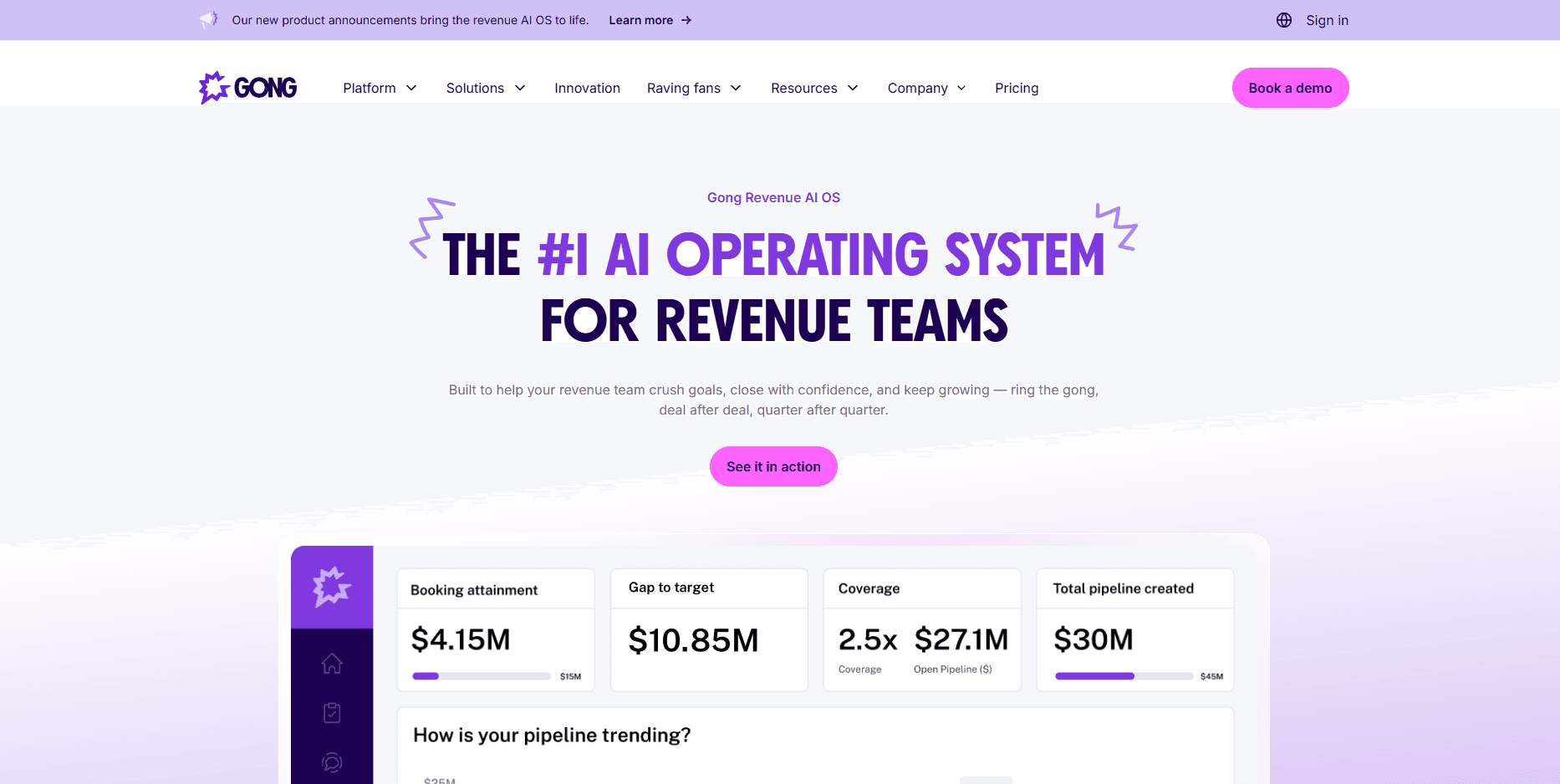
Gong is an AI platform that helps Go-to-Market (GTM) teams work smarter and grow faster. It tracks customer calls and meetings, studies the data, and uses “Revenue AI” to share insights, improve coaching, automate tasks, and make forecasts more accurate.
Key features of Gong
Gong Engage to prioritize and personalize sales engagement
Gong Forecast for unbiased, AI-powered pipeline and revenue forecasting
Gong Agents to automate follow-ups, pipeline edits, and forecast corrections
Gong Data Engine to unify customer data and simplify management
Conversation Intelligence to coach reps, track deals, and uncover performance drivers
Pros and cons of Gong
Gong gives revenue teams deep visibility and strong forecasting. Still, it has its limits on CRM connections and reporting options.
Pros | Cons |
|---|---|
Strong conversation intelligence with full visibility into deals and rep performance. | Can only connect to one CRM at a time, which may be limiting for companies using multiple systems. |
Forecasting and pipeline analytics improve predictability for GTM leaders. | Some users say the platform lacks built-in tools for sharing recaps with leadership. |
The platform works across 70+ languages, helping distributed teams stay aligned. | Some users say reporting customization options are limited. |
Price for Gong
Gong customizes pricing by team size with per-user licensing and a platform fee. The platform includes tech stack integrations without additional charges.
When Gong fits best
Gong works for GTM teams needing revenue cycle visibility from prospecting through renewals. It delivers confident forecasting, real conversation coaching, and workflow automation.
Large revenue teams gain from this scope. Smaller or niche groups may face unnecessary cost and complexity.
6. CallMiner

CallMiner analyzes customer interactions to uncover patterns in conversation data. It tracks sentiment, flags recurring issues, and identifies trends in how customers respond. Teams with dedicated analysts or business intelligence functions use it for deep analytics.
Key features of CallMiner:
Advanced conversation intelligence with AI and NLP to detect sentiment, emotion, and behaviors
Root cause and trend analysis identifying performance gaps and improvement opportunities
Keyword and phrase spotting for real-time issue detection
Call monitoring and recording with AI-driven flagging
Pros and cons of CallMiner
CallMiner delivers deep analytics for insight-focused teams, but lacks tools to turn findings into performance improvement.
Pros | Cons |
|---|---|
Powerful analytics engine processes millions of interactions. | Users report that coach dashboards feel overly complex for team leaders, especially those new to the platform. |
Boosts agent performance and customer experience with AI insights and automation. | Reviews mention premium pricing with add-ons makes stakeholder buy-in challenging and creates pressure for immediate ROI. |
Advanced sentiment and emotion detection across conversations. | Reviews say the syntax takes time to master, with some analysts reporting a 6-month learning curve before feeling comfortable. |
Price for CallMiner
CallMiner provides custom pricing through direct quotes only.
When CallMiner fits best
CallMiner works for large contact centers with dedicated analyst teams focused on understanding customer experience trends and the "why" behind performance gaps.
Organizations wanting coaching workflows that directly improve agent performance should look at platforms built for frontline enablement.
How we tested these call center quality monitoring tools
QA software makes big promises, but the real question is: Does it deliver for your team? Here’s how we tested these call center quality monitoring software:
We looked at coverage, because a few random calls don’t give the full picture. The best tools review every interaction and highlight patterns managers can act on.
We look for coaching depth, since monitoring is only useful if it improves performance. Strong platforms give reps feedback they can use, often tied to specific lines in the conversation.
We considered ease of use, because a tool only works if people adopt it. We asked how quickly managers and reps could start and see results.
Our testing process
We combined product analysis with feedback from real users. Then we reviewed G2 and Capterra comments from 2025 to see how these call-center quality assurance software tools work in real life.
We also studied each vendor’s website to spot gaps or missing features. These insights showed us what works in practice and helped us filter out the rest.
Which call center quality monitoring software should you choose?
Choose the call center quality monitoring software that best fits the scale of your company, your sector, and your goals. What works best for one contact center may not work for another.
Choose Alpharun if you:
Run large sales teams in regulated industries like insurance, mortgages, or healthcare where compliance isn't optional
Require enterprise-grade security with SOC 2 Type 2 and HIPAA compliance built in, not bolted on
Want to reduce ramp times and close performance gaps across hundreds of reps by codifying what your best performers actually do, then scaling it across the team
Need 100% QA coverage paired with coaching that ties back to exact call moments
Want every call reviewed with coaching that shows reps the exact moments and phrases top performers use to succeed
Use AI voice agents to automate after-hours lead qualification, scheduling, and routine information gathering
Choose Observe.AI if you:
Want voice-first AI agents that deliver natural, human-like customer conversations
Need to automate routine calls so agents can focus on complex interactions
Choose Balto if you:
Run a B2C contact center where real-time prompts can save at-risk calls
Care most about keeping agents on script and compliant during live conversations
Choose Cresta if you:
Operate a large, complex contact center and want real-time augmentation plus automation
Value wide integrations and omnichannel coverage
Choose Gong if you:
Manage GTM or RevOps teams requiring forecasting, pipeline tracking, and rep coaching
Care more about deal intelligence than call center QA
Choose CallMiner if you:
Have dedicated analyst teams focused on customer experience trends and root cause analysis across large call volumes
Prioritize analytics over coaching and can integrate separate performance improvement tools
Avoid these tools if you:
Run a very small contact center where enterprise pricing outweighs the benefits
Only need basic call recording and reporting, not coaching or performance management
Want a quick setup, but aren’t ready to invest time in integrations and adoption
What we learned about call-center quality monitoring software
Call-center quality tools solve different problems. Some focus on compliance. Others highlight real-time guidance or sales forecasting. The right choice depends on your team’s size and priorities.
Alpharun is a practical choice for call centers because:
It analyzes every call and identifies what separates your best reps from the rest.
The tool transforms those insights into playbooks.
Alpharun connects feedback to exact conversation timestamps for clear examples.
Your team gets coaching they can actually use.
For larger teams, this approach builds consistency and closes the gaps left by manual QA. Smaller centers may prefer lighter tools. But when scale and accuracy matter, platforms like Alpharun provide the structure leaders need to manage performance with confidence.
Stop guessing what happens on calls and start reviewing every conversation with Alpharun. Schedule a demo today.

